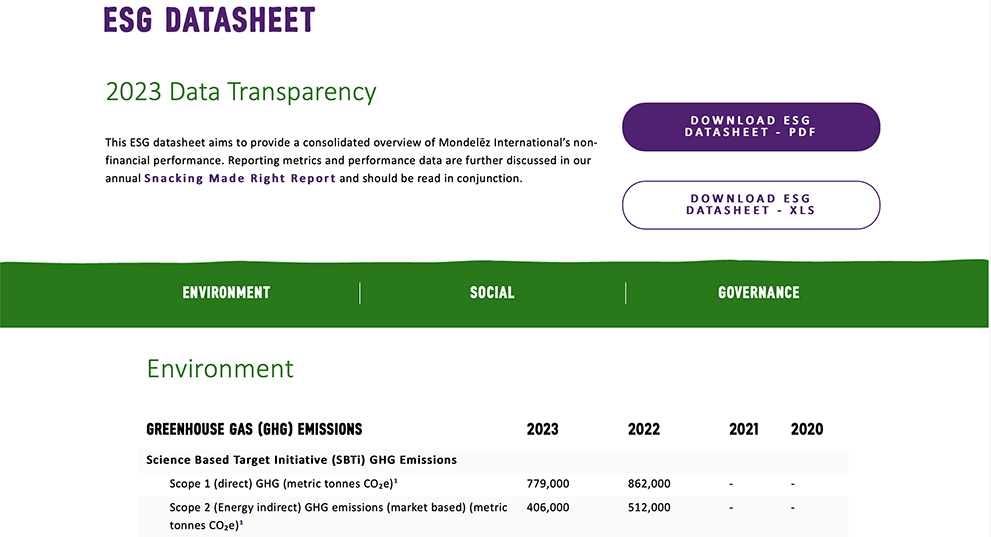Progress not perfection


Mondelēz is a best practice example of a company that transparently communicates progress by providing data in HTML, PDF and Excel formats.
"As corporate digital managers, many ESG issues are simply not in your control... but what you can control is how you communicate about it". At the 2024 Conference Board Corporate Communications Conference in New York, Dan Strechay, Director of Sustainability, Communications and Engagement at Mars, shared some insights on green-hushing.
The current backlash against ESG has led some companies to stop communicating on their environmental and sustainability work all together. For companies that do communicate, there is increasing pressure to only share success stories, such as when a goal has been achieved, or a milestone has been hit. This can result in Sustainability sections on corporate websites that read like one long highlight reel: not very authentic.
Bowen Craggs research shows that a variety of key stakeholder groups increasingly want to see transparency instead of perfection when it comes to communicating a company's environmental and social impact – even if the progress so far is not 100% flattering.
Communicating progress rather than perfection can seem fraught with risk, but there are many benefits of doing this:
- Firstly, communicating progress towards a milestone gives corporate digital teams the opportunity to communicate the same message in different ways, creating more of an impact over time and making it more likely that messages actually get digested. Mars is an example here: the company uses “always on” storytelling, particularly in the form of frequent LinkedIn posts, to communicate its sustainability work in bite-sized, engaging updates. The company also publishes articles that show the next stage towards a goal, linking to previous articles along the way, as in this article about sustainable fishing. As Dan Strechay argues, this approach is better than a "100 page sustainability report that nobody reads".
- And it's not just about frequent updates on social media: Bowen Craggs visitor research data shows that one in seven visits to corporate websites include looking at sustainability information. Not only do visitors look at it, but they engage with the content: the average session duration for website content in general is 1minute 49 seconds, whereas for sustainability information it is 6 minutes and 30 seconds. There is value in ensuring that the Sustainability section on the corporate website is as engaging and informative as possible.
- What's more, Bowen Craggs recent research into what the next generation of stakeholders want from corporate websites shows that many jobseekers take a company's approach to sustainability into account when they are choosing what jobs to apply for.
- Finally, professional audiences, including environmental and social experts and analysts, value as much transparency as possible from companies. As one high-performing corporate digital team shared in a recent Bowen Craggs Roundtable, "even if analysts and environmental and social experts are not favourable about the company, the more data you provide, the better, because at least you get transparency points."
Bowen Craggs recommends:
So, how do you do this?
One solution is to clearly and transparently communicate progress against your environmental and social targets. The gold standard would be to have an HTML table that clearly shows the targets and the work over the years towards them, as well as an indication of whether or not the company is on track. The best companies in the Index go into much more detail than others when it comes to providing this data in HTML, PDF and Excel sheets. Mondelēz is a best practice example of a company that does this well by providing data in HTML, PDF and Excel formats.
Communicating progress towards goals could also take the form of case studies that put a human face on abstract concepts like climate change, as Shell does in its "Powering our Progress in action" section.
Inviting team members to speak about the work they have been doing is also an effective method of telling a progress story. Showcasing employees keeps everyone in the business in the loop and is good for internal recognition.
As one ESG analyst said in an interview with Bowen Craggs, “It is always about acknowledging your current status quo and showing a credible path forward. What are the actions that you plan to do, and be very specific about it. You need to show progress every year.” Insurance company Aviva's annual Gender Pay Gap report is an example of transparency: the company acknowledges that there is work to be done, but that progress is possible.
However, as always, be wary of having too much content or duplicating sustainability information across too many channels, as this makes it harder to ensure that everything is kept up to date, and can make it harder for visitors to find what they are looking for. In the words of another high-performing corporate digital team at a recent Roundtable, "too much content can obscure the most important truths."
Another risk to highlight is that in some companies, the idea of admitting any sort of failure will be seen as unnecessarily inviting criticism, and there could be legal implications. However, starting with publicly reported data and employee stories is a good way to go, because this data is already on record, and employee stories will naturally provide context around the intentions and goals. Reporting progress that is not on track can be tricky, and it is often easier to just stay quiet, so when reporting progress, try integrating the progress story within a wider story about other targets that have been achieved.
As one ESG professional we spoke to as part of our Next Generation research told us, "It does not necessarily matter how far along with the [reputation] process a company is, but transparency is key.”
Communicating progress, not perfection, is more authentic and transparent, and more likely to be read by your key audience groups.